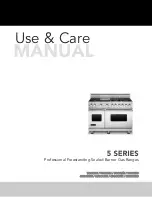
45
© 2012 Viking Preferred Service
WARNING
To avoid risk of electrical shock, personal injury, or death, disconnect electrical power to unit using power
switch before servicing. Wires removed during disassembly must be replaced on proper terminals to insure
correct earth ground and polarization. After servicing, reconnect power using power switch.
Ice Maker (continued)
cube release. Mineral content can also restrict
saddle valves. Verify water supply line is ON, water
pressure is not below 20 psi, saddle valve is fully
open and clear of restrictions. Fully close and open
valve to dislodge sediment (if necessary, remove
valve and enlarge pierced hole to 3/16” diameter
with a drill and reinstall saddle valve). Ensure water
line to unit is not pinched/kinked/or clogged, ice is
not present in inlet tube blocking water flow, or water
pressure is not above 120 psi.
Water fill can be increased by turning the adjustment
screw counterclockwise and decreased by turning
the screw clockwise. One-half turn will adjust the fill
by approximately two thirds of an ounce. If supply
is OK replace water valve. If no voltage is present,
verify harness. If OK, replace module.
Thermal Cut out (TCo)
The TCO is a safety device and must NOT be
bypassed. If the TCO is found to be electrically
open, this indicates an overheat in the ice maker and
the ice maker must be replaced.
Component Testing–Ice maker
Module ohmmeter Checks with no power to Ice maker and ejector Blades in end of Cycle
Test points
Component
Module position
ohms
L-H
Mold & Heater
Attached to Support
264
L-M
Motor
Separate from Heater
16,100
Module voltage Checks with Motor or Test light power to Ice maker
Test points
Component
line voltage
0 volts
T-Module
Power ON
Power OFF
Power OFF
T-H
Bimetal
Open
Closed
L-H
Heater
ON
OFF
L-M
Motor
ON
OFF
N-V
Water Valve
ON
OFF
Service Diagnostics and procedures–Disassembly
TCO














































